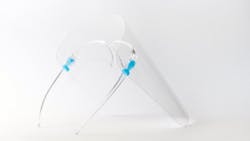The case for face shields: Why they should remain the standard
The pandemic brought about unprecedented changes to dentistry, including the introduction of increased levels of personal protective equipment (PPE). When most think of PPE, masks are the first thing that comes to mind. While it’s true that masks have been vital in slowing the spread of COVID-19, for practicing dental professionals, face shields are just as important. In this stage of the pandemic, as some dental offices loosen PPE requirements, face shields should remain an integral part of our infection control protocol.
Meeting an overwhelming need
In response to the severe shortage of PPE at the onset of the COVID-19 pandemic, many manufacturers stepped up to meet the need. These companies were not originally in the PPE business, but modified equipment to meet the needs of frontline workers. Supply hoarding and panic purchasing left existing manufacturers struggling to increase production. American consumers bought large supplies of PPE as the sheer scale of the crisis and the severity of the disease prompted a surge in buying, hoarding, and reselling masks, gloves, and shields. In March 2020, Amazon cancelled more than half a million offers to sell masks at inflated prices and closed 4,000 accounts for violating fair pricing policies.1 American dental and medical supplies were quickly fortified by companies who used existing equipment to develop PPE and sell at fair prices. From sporting goods corporations to construction companies, automakers, even distilleries, American ingenuity came through when we needed it most. One such company, Burton Snowboards, retooled its 10,000-square-foot snowboard facility in Burlington, Vermont, where it normally prototypes new board designs, to make face shields for hospitals.2
PPE recommendations
At the onset of the pandemic, dental offices were desperate for guidance from the Centers for Disease Control and Prevention (CDC) and the American Dental Association (ADA) for protocols for keeping patients and employees safe. While dental offices were closed, dental hygienists were busy researching how they would reenter the office safely. Hair coverings became the norm, as did disposable gowns and face shields. While medical settings have utilized these items routinely, many hygienists practiced only in scrubs, lab coats, safety glasses/loupes, and masks. Enter COVID, and along with it came caps, disposable gowns, an N95 mask with a level-3 over it, eyewear, and shields. We all began to look like aliens in the eyes of our patients.
Face shields are meant to be worn in conjunction with other PPE, such as surgical or N95 masks, and can make them last longer by keeping them dry and free from spatter. The overall specifications to build face shields are not as stringent as with face masks or respirators. However, any dental clinician will tell you that face shields that are not crystal clear, scratch-resistant, or dent-proof make our job even harder. Working in the mouth is hard on hygienists’ bodies under ideal circumstances, but add all this new PPE and it is particularly strenuous. Many varieties of mass-produced, low-cost face shields don’t cover enough of the side or lower half of the face, fail to accommodate a light, or leave an opening on the top for aerosols to enter. This problem exists in the medical community as well, notes the American Medical Association (AMA) newsletter Delivering Health: “Medicine itself can be mentally draining because it’s a lot of problem solving and figuring things out, but then when you add on those actual physical layers that you need to wear, and particularly when those physical layers don’t fit well, it takes an extra toll because you’re having to perform at the same level of mental output while also dealing with that physical drain on your body.”3
Face shields remain vital
After utilizing this set of PPE recommendations for nearly two years, there has been a relaxing of their use by dental hygienists. A recent poll of 100 hygienists revealed that some no longer wear a shield because of the difficulty accommodating it over a light, heaviness, or getting too warm. Glare or other visibility issues were also cited. High-quality shields were often not supplied, with offices opting for low-cost ($3 range) shields. These lower cost shields—meant to be disposable, yet worn for months—tend to be ill-fitting and have more visibility issues. What are the repercussions of eliminating face shields? According to Dr. Tim Landis, a California dentist who designed the first commercially available dental shield in 1985, the consequences can be dire. “Because of the path of air that does pass between the fibers of the masks, the air is ‘filtered’ at about three to five microns; but viruses are about 100 nanometers. This is about 35 to 50 times too small to be caught in the paper material.”4
Related reading:
- In the eye of the COVID-19 storm: An eye protection forecast
- Utility gloves: Why do we hate wearing them?
- The need for COVID-19 nasal protection is as plain as the nose on your face
Take into account moisture from droplets, spatter, and moisture from your own face and breath. This renders the filtering ability to an even lower rate. Viruses carried in aerosol droplets will not be filtered in a moist mask. In an ideal world, we would all wear a new N95 mask (properly fitted to our face) before seeing each patient. I don’t know any hygienists whose office could provide this, and I doubt any hospitals could. We are still in a state of shortage when it comes to good quality masks. It just makes sense to stop the onslaught of aerosol droplets, spatter, blood, debris, calculus, and whatever else may fly at us by simply wearing a high-quality shield. Hold your shield up to your light after working on a patient, and you’ll be convinced. Just be sure your shield is good quality, crystal clear, and long enough to touch your chest to keep anything from entering underneath. Dr. Landis is currently designing an Op-d-op shield that will close the gap at chin level for wearers of the new forward-view ergonomic loupes. The top must be closed so aerosols and debris cannot enter from above.
Looking ahead
We have experienced a pandemic that shook us to our very core. We now know that an unknown pathogen can be introduced at any unforeseen time. If our protocols remain at COVID levels, hygienists will be prepared. We will already be used to the process of doing hygiene in full PPE, and we’ll give our patients the sense of well-being that they’ve come to expect.
Editor's note: This article appeared in the April 2022 print edition of RDH magazine. Dental hygienists in North America are eligible for a complimentary print subscription. Sign up here.
References
- Cabral L, Xu L. Seller reputation and price gouging: evidence from the COVID-19 pandemic. Economic Inquiry. 2021;59(3):867-879. http://leixu.org/xu_price_gouging.pdf
- Cerullo M. How companies pivoted from making dresses, snowboards and whisky to face masks, gloves and sanitizer. CBS News. March 10, 2021. https://www.cbsnews.com/news/ppe-manufacturing-business-transformations/
- Berg S. He took on state’s top public health job. Then the pandemic hit. American Medical Association. September 2, 2020. https://www.ama-assn.org/delivering-care/public-health/he-took-state-s-top-public-health-job-then-pandemic-hit
- Tim Landis, DDS, owner of Op-d-op. Phone and email conversations, 2022.
About the Author

Linda Rhoades, BS, RDH
Linda Rhoades, BS, RDH, has been a dental hygienist for 42 years and enjoys writing, speaking, and mentoring her fellow dental hygienists. She was the 2021 recipient of the Irene Newman award from ADHA, and is author of the book Irene Newman: The World’s First Dental Hygienist.
